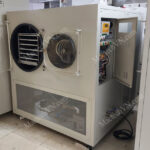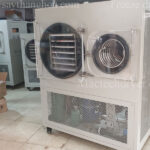On the market today, there are many types of dryers used in fields such as the production of dried vegetables, dried foods, dried medicinal herbs, and dried seafood. However, choosing the type of dryer that is most suitable for the product to be dried and the allowable cost is not an easy problem. Because the same product can be dried by many types of dryers, or just changing the drying requirements of a product can change the type of dryer to use. In this content, the author will mention the current types of dryers, the advantages and disadvantages of heat dryers, and the scope of use of each type so that you have more knowledge when choosing the product that is most suitable for the product to be dried.

General introduction to dryer types
The types of dryers currently available on the market include heat dryers (also known as household dryers), cold dryers (also known as cool dryers), vacuum dryers, and freeze dryers. Each type of dryer will have a certain range of use, depending on each type of product and each drying requirement of the manufacturer, the appropriate machine must be selected. Choosing the right dryer needs to be carefully researched or carefully consulted to avoid wasting money or buying a dryer that does not meet the drying requirements.
1. Heat dryer: this is the most popular type of household dryer today, can dry a variety of products, meeting a variety of requirements for drying, soft drying, and crispy drying. Heat dryers have a wide drying temperature range, usually from 30-100oC for common drying products such as vegetables, fruits, meat, starch, and medicinal herbs of all kinds. A Higher drying temperature range from 100-300oC is used to dry industrial products in various industries such as circuit boards, plastic molds, paints, and printed circuits…
2. Cold dryer: this is a more advanced dryer than the heat dryer, mainly used to dry products that easily change properties when exposed to high temperatures such as vegetables, fruits, medicinal herbs, and turmeric. The above products are also often dried by heat dryers but at temperatures lower than 60oC. Cold dryers allow drying at a temperature range of 10-50oC, so the above products will be dried at even lower temperatures and dry faster because the cold dryer has a steam condensation system in the drying chamber.
3. Vacuum dryer: this drying equipment requires a low-pressure drying environment (in the drying chamber) to reduce the boiling point of water, helping the product evaporate water faster at low temperatures, and ensuring that the product retains its color and nutrients better.
4. Freeze dryer: also known as freeze drying, this drying equipment can be said to be very high-end, allowing drying at temperatures below 0oC, the amount of water in the product is frozen and then converted to steam, and the product dries quickly, retaining its original structure.

Advantages and disadvantages of heat dryers compared to other dryers
In fact, current dried products such as dried radish, dried carrot, dried apple, dried grape, dried bamboo shoot, dried beef, dried chicken, dried pork, and dried fish. Dried medicinal herbs such as cordyceps, dried lingzhi mushrooms, mushrooms, herbs, starch… dried grains, and beans… all use heat dryers to meet the necessary drying, soft drying, and crispy drying requirements. Therefore, heat dryers are more popular than other types of dryers.
Freeze dryers, vacuum dryers, and freeze dryers are used with strict drying requirements, keeping natural color, properties, texture, and nutritional content better.
In addition to the advantage of being suitable for a variety of purposes of heat dryers, the price of the machine is also an advantage of this product, the price of the machine is suitable for the investment capacity of small businesses, so it meets most of the drying needs in practice.
On the contrary, the cold dryer and the other two types of dryers are quite expensive, so they should only be used for high-value products. Therefore, the heat dryer is still the priority.
Conclusion: Each type of dryer has different advantages and disadvantages, and different scopes of use, so customers need to be specifically advised by the manufacturer to choose the machine that suits their needs. Above are some comments on the advantages and disadvantages of heat dryers so that customers have more knowledge about the types of dryers to help them choose the right product. Thank you for following the content.










